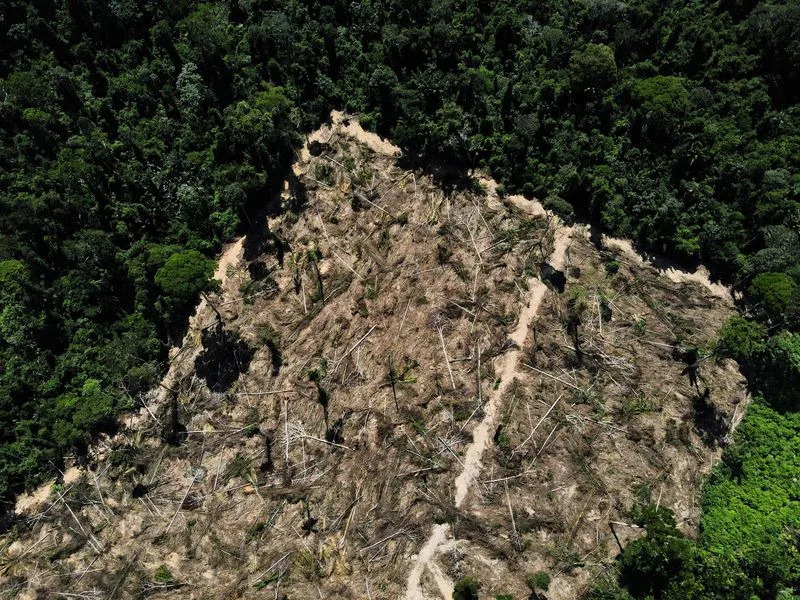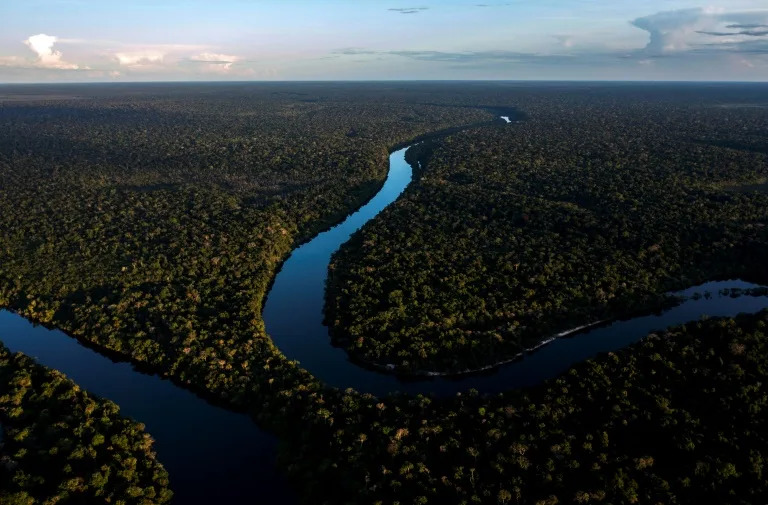Jake Spring
Updated Mon, November 13, 2023

A view of a deforested area in the middle of the Amazon forest in the municipality of Uruara, Para, Brazil
SAO PAULO (Reuters) - Restoring global forests could sequester 22 times as much carbon as the world emits in a year, according to a scientific study published on Monday, making the case that trees are a key tool in confronting the climate crisis along with cutting fossil fuels.
The study considers restoring forests where they would naturally exist if not for humans, either by allowing degraded woodlands to regrow or by reforesting denuded areas, but excludes areas vital to agriculture or already turned into cities.
Reaching the world's full potential for restoration would draw out an estimated 226 gigatonnes of excess carbon from the atmosphere - or roughly one-third the amount added to the atmosphere since the industrial revolution, the research finds.
"There cannot be a choice between nature and decarbonising. We absolutely must take steps to achieving both simultaneously," said ecologist Thomas Crowther of Switzerland's Federal Institute of Technology Zurich.
The paper, published in the journal Nature by Crowther and more than 200 other researchers, offers a major update to a 2019 paper that sparked fierce debate in the scientific community.
The new findings show that, while forests can help to combat climate change, it is counterproductive to use them to offset future greenhouse gas emissions, Crowther said. Any additional emissions will exacerbate climate change and extreme weather, damaging forests and hurting their ability to absorb carbon. That would negate the benefits of an offset, he said.
The idea of earning an offset through simply planting trees "is now categorically against what the science says," Crowther said.
Crowther said he plans to attend the upcoming United Nations COP28 climate summit in Dubai to deliver that message to policymakers.
"This paper has to be the one to kill greenwashing," he told Reuters.
TREE CONTROVERSY
The research follows on a landmark 2019 study also co-authored by Crowther, indicating that 205 gigatonnes could be sequestered by forest restoration. Salesforce CEO Marc Benioff read the study and was inspired to work with the World Economic Forum to develop its initiative to plant a trillion trees.
But the paper and the trillion trees effort - which was quickly endorsed by then-U.S. President Donald Trump - set off a controversy among scientists and environmentalists.
Many scientists - as well as Swedish activist Greta Thunberg - said trees were being presented as an overly simplistic cureall for the climate crisis that could distract from efforts to reduce the use of fossil fuels, the main culprit for climate change.
Crowther said the response drastically oversimplified the paper's message.
More than 40 scientists wrote in the journal Science that the 2019 study may have inflated the carbon sequestration potential of forest restoration by 4-5 times by considering tree planting in non-forest ecosystems among other oversights.
Joseph Veldman, an ecologist at Texas A&M University and lead author of that criticism, said he thinks the new paper still exaggerates how much carbon could be sequestered, potentially by half.
He said the 226 gigatonne figure includes carbon sequestered in places that are "inappropriate" for planting trees, like at high altitudes, and overly rely on forest gains in savannas, among other concerns.
"This is like the absolute, absolute upper bound of what could possibly ever be fathomable," Veldman said. "You're never going to get there. It's unwise and it's not feasible."
Crowther said that while the current and previous study show where trees could be planted, it did not mean that they necessarily should be planted there.
The study's authors specify that restoration must be done a certain way to be effective.
They argue that forests must be diverse, rather than mass plantings of a single species, and restoration must serve local community needs.
Cristina Banks-Leite, a tropical ecologist, teaches the 2019 Crowther paper and a paper that criticized it in the first week of her master's course at Imperial College London to illustrate the debate around forests in the scientific community.
Doing such complex measurements for the whole world is always going to have some flaws, but also improves with technology advances, she said.
The paper also finds that protecting existing forests is more beneficial than trying to regrow them. Of the total carbon sequestration potential, only 39% would come from reforesting denuded areas. Most of the carbon gains, an estimated 61%, would come simply from protecting forests that are still standing and allowing degraded woodlands to recover.
"The take-home message - that the forest that we have should be protected - is absolutely foundational and correct," said ecologist Nicola Stevens at University of Oxford, who had co-authored the criticism of Crowther's earlier paper.
(This story has been corrected to say 226 gigatonnes of carbon, not carbon dioxide, in paragraph 3)
(Reporting by Jake Spring; Editing by Katy Daigle and Sandra Maler)
Forests could absorb much more carbon, but does it matter?
Sara HUSSEIN
Mon, November 13, 2023

A new study finds forests could absorb vastly more carbon with better protection (MAURO PIMENTEL)
Protecting forests globally could vastly increase the amount of carbon they sequester, a new study finds, but given our current emissions track, does it really matter?
For Thomas Crowther, an author of the assessment, the answer is a resounding yes.
"I absolutely see this study as a cause for hope," the professor at ETH Zurich said.
"I hope that people will see the real potential and value that nature can bring to the climate change topic."
But for others, calculating the hypothetical carbon storage potential of global forests is more an academic exercise than a useful framework for forest management.
"I am a forester by trade, so I really like to see trees grow," said Martin Lukac, professor of ecosystem science at University of Reading.
However, he considers forest carbon potential calculations like these "dangerous," warning they "distract from the main challenge and offer false hope."
Crowther has been here before: in 2019 he produced a study on how many trees the Earth could support, where to plant them and how much carbon they could store.
"Forest restoration is the best climate change solution available today," he argued.
That work caused a firestorm of criticism, with experts unpicking everything from its modelling to the claim that reforestation was the "best" solution available.
Nodding to the furore, Crowther and his colleagues have now vastly expanded their data set and used new modelling approaches for the study published Monday in the journal Nature.
They use ground-sourced surveys and data from three models based on high-resolution satellite imagery.
The modelling approach is "as good as it currently gets," acknowledged Lukac, who was not involved in the work.
- 'Achieve climate targets' -
The study estimates forests are storing 328 gigatons of carbon less than they would if untouched by human destruction.
Estimates of the world's remaining carbon "budget" to keep warming below the 1.5C range from around 250-500 gigatons.
Much of the forest potential -- 139 gigatons -- could be captured by just leaving existing forests to reach full maturity, the study says.
Another 87 gigatons could be regained by reconnecting fragmented forests.
The remainder is in areas used for agriculture, pasture or urban infrastructure, which the authors acknowledge is unlikely to be reversed.
Still, they say their findings present a massive opportunity.
"Forest conservation, restoration and sustainable management can help achieve climate targets by mitigating emissions and enhancing carbon sequestration," the study says.
Modelling and mapping the world's forests is a tricky business.
There's the scale of the problem, but also the complexity of what constitutes a forest.
Trees, of course, but the carbon storage potential of a woodland or jungle is also in its soil and the organic matter littering the forest floor.
- Trees versus emissions? -
Ground-level surveys can offer granular data, but are difficult to extrapolate.
And satellite imagery covers large swathes of land, but can be confounded by something as simple as the weather, said Nicolas Younes, research fellow at the Australian National University.
"Most of the places where there is potential for carbon storage are tropical countries... these are places where there is persistent cloud cover, therefore satellite imagery is very hard to validate," he told AFP.
Younes, an expert on forest remote sensing, warns the complexity of the study's datasets and modelling risks introducing errors, though the resulting estimates remain "very valuable".
"It will not show us the exact truth for every pixel on Earth, but it is useful."
One objection to quantifying forest carbon potential is that conditions are far from static, with accelerating climate change, forest fires and pest vulnerability all playing a role.
And, for Lukac, whatever potential forests have is irrelevant to the urgency of cutting emissions.
The study's estimated 328 gigatons "would be wiped (out) in 30 years by current emissions," he said.
Crowther, who advises a project to plant a trillion trees globally, rejects an either-or between forest protection and emissions reduction.
"We urgently need both," he said.
No comments:
Post a Comment